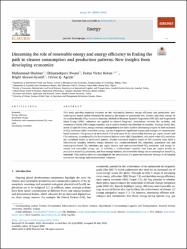| dc.contributor.author | Shahbaz, Muhammad | |
| dc.contributor.author | Nwani, Chinazaekpere | |
| dc.contributor.author | Bekun, Festus Victor | |
| dc.contributor.author | Gyamfi, Bright Akwasi | |
| dc.contributor.author | Agozie, Divine Q. | |
| dc.date.accessioned | 2023-11-01T09:19:42Z | |
| dc.date.available | 2023-11-01T09:19:42Z | |
| dc.date.issued | 2022 | en_US |
| dc.identifier.issn | 0360-5442 | |
| dc.identifier.issn | 1873-6785 | |
| dc.identifier.uri | https://hdl.handle.net/11363/6158 | |
| dc.description.abstract | This study provides empirical evidence on the relationship between energy efficiency and production- andconsumption based carbon emissions by assessing the impact of population size, income, and clean energy on
the carbon dioxide (CO2) emissions function. Method of Moments Quantile Regression (MM-QR) and Augmented
Mean Group (AMG) estimators are applied to observe long-term associations between the variables, and
Dumitrescu-Hurlin (DH) Ganger causality test is used to identify the direction of causality. Findings reveal that,
across all specifications, energy intensity and population size have positive (increasing) impact on both estimates
of CO2 emissions while renewable energy use has a negatively significant impact and stronger on consumptionbased estimates. The presence of an inverted U-shaped curve in the relationship between per capita income and
CO2 emissions, as predicted by the Environment Kuznets curve (EKC) hypothesis, only exists when CO2 emissions
are calculated based on production pattern. Further empirical analysis based on DH causality tests show a
bidirectional causality between energy intensity and production-based CO2 emissions, population size and
consumption-based CO2 emissions, per capita income and consumption-based CO2 emissions, and energy intensity and renewable energy use. In addition, a unidirectional causality runs from per capita income to
production-based CO2 emissions, and from energy intensity and renewable energy use to consumption-based CO2
emissions. This analysis outlines a paradigm for the formulation of a green development strategy in developing
economies via energy and environmental resources. | en_US |
| dc.language.iso | eng | en_US |
| dc.publisher | PERGAMON-ELSEVIER SCIENCE LTD, THE BOULEVARD, LANGFORD LANE, KIDLINGTON, OXFORD OX5 1GB, ENGLAND | en_US |
| dc.relation.isversionof | 10.1016/j.energy.2022.124951 | en_US |
| dc.rights | info:eu-repo/semantics/openAccess | en_US |
| dc.rights | Attribution-NonCommercial-NoDerivs 3.0 United States | * |
| dc.rights.uri | http://creativecommons.org/licenses/by-nc-nd/3.0/us/ | * |
| dc.subject | Energy efficiency | en_US |
| dc.subject | Renewable energy | en_US |
| dc.subject | Production and consumption-based CO2 emissions | en_US |
| dc.subject | Developing economies | en_US |
| dc.title | Discerning the role of renewable energy and energy efficiency in finding the path to cleaner consumption and production patterns: New insights from developing economies | en_US |
| dc.type | article | en_US |
| dc.relation.ispartof | Energy | en_US |
| dc.department | İktisadi İdari ve Sosyal Bilimler Fakültesi | en_US |
| dc.authorid | https://orcid.org/0000-0003-4451-1833 | en_US |
| dc.authorid | https://orcid.org/0000-0003-4948-6905 | en_US |
| dc.identifier.volume | 260 | en_US |
| dc.identifier.startpage | 1 | en_US |
| dc.identifier.endpage | 12 | en_US |
| dc.relation.publicationcategory | Makale - Uluslararası Hakemli Dergi - Kurum Öğretim Elemanı | en_US |
| dc.contributor.institutionauthor | Bekun, Festus Victor | |



















